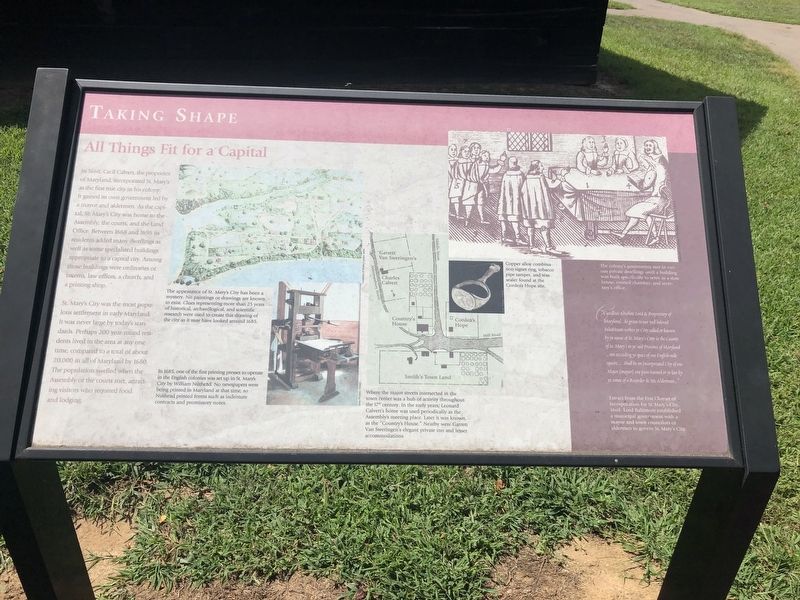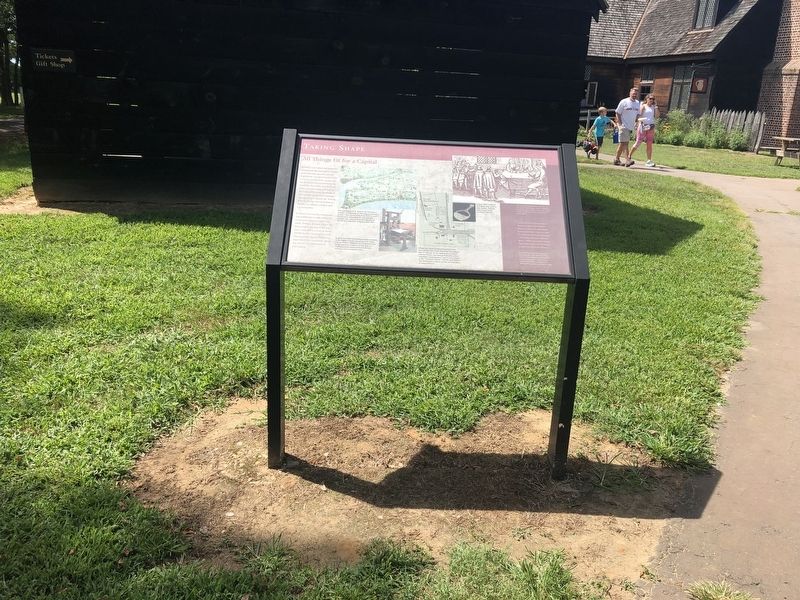St. Mary's City in St. Mary's County, Maryland — The American Northeast (Mid-Atlantic)
All Things Fit for a Capital
Taking Shape
St. Mary's City was the most populous settlement in early Maryland. It was never large by today's standards. Perhaps 200 year-round residents lived in the area at any one time, compared to a total of about 20,000 in all of Maryland by 1680. The population swelled when the Assembly or the courts met, attracting visitors who required food and lodging.
[Captions:]
The appearance of St. Mary's City has been a mystery. No paintings or drawings are known to exist. Clues representing more than 25 years of historical, archaeological, and scientific research were used to create this drawing of the city as it may have looked around 1685.
In 1685, one of the first printing presses to operate in the English colonies was set up in St. Mary's City by William Nuthead. No newspapers were being printed in Maryland at the time, so Nuthead printed forms such as indenture contracts and promissory notes.
Where the major streets intersected in the town center was a hub of activity throughout the 17th century. In the early years, Leonard Calvert's home was used periodically as the Assembly's meeting place. Later it was known as the "Country's House." Nearby were Garrett Van Sweringen's elegant private inn and lesser accommodations.
The colony's government met in various private dwellings until a building was built specifically to serve as a state house, council chamber, and secretary's office.
"Caecillius Absolute Lord & Proprietary of MAryland...do grant to our well beloved Inhabitants within ye Citty called or known by ye name of St. Mary's Citty in the County of St. Mary's in ye said Province of Maryland...not exceeding ye space of one English mile square... Shall be an Incorporated City of one Major [mayor] one pson learned in ye law by ye name of a Recorder & Six Alderman..."
Extract from the first Charter of Incorporation of St. Mary's City, 1668. Lord Baltimore established a municipal government with a mayor and town councilors or aldermen to govern St. Mary's City.
Erected by Historic St. Mary's City.
Topics. This historical marker is listed in these topic lists: Colonial Era
Location. 38° 11.16′ N, 76° 26.034′ W. Marker is in St. Mary's City, Maryland, in St. Mary's County. Marker can be reached from Old State House Road north of Point Lookout Road (Maryland Route 5), on the left when traveling north. Touch for map. Marker is at or near this postal address: 47414 Old State House Road, Saint Marys City MD 20686, United States of America. Touch for directions.
Other nearby markers. At least 8 other markers are within walking distance of this marker. Out the Door (within shouting distance of this marker); Welcome to the Waterfront (within shouting distance of this marker); From Many Lands (within shouting distance of this marker); Meet Garrett Van Sweringen (within shouting distance of this marker); The Van Sweringen Site (within shouting distance of this marker); The Van Sweringen Family (within shouting distance of this marker); Upon This Shore (within shouting distance of this marker); An Innovative Entrepreneur (within shouting distance of this marker). Touch for a list and map of all markers in St. Mary's City.
Credits. This page was last revised on September 4, 2019. It was originally submitted on September 4, 2019, by Devry Becker Jones of Washington, District of Columbia. This page has been viewed 111 times since then and 9 times this year. Photos: 1, 2. submitted on September 4, 2019, by Devry Becker Jones of Washington, District of Columbia.

